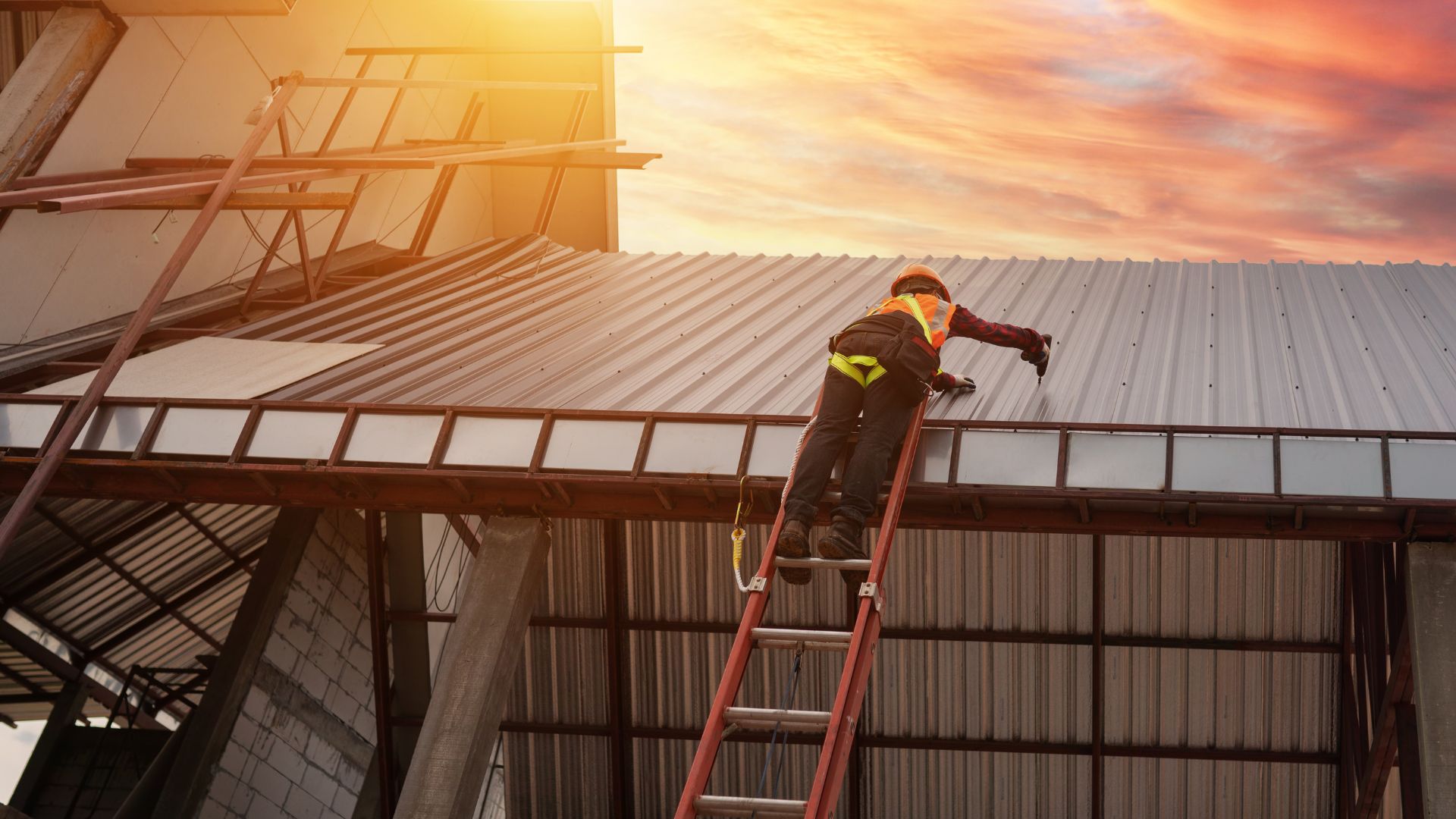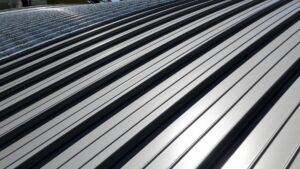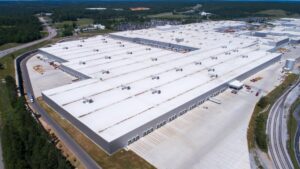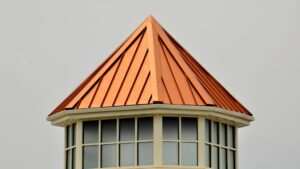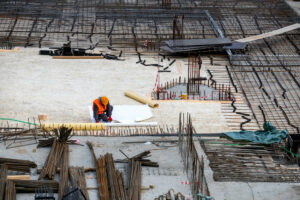Choosing the right roof can be confusing. One fact to know is that metal roofs last between 40-70 years. Our article will uncover the durability of different metal roofs and what affects their lifespan.
Keep reading to learn more!
Key Takeaways
- Metal roofs have a long lifespan, ranging from 40 to 70 years, which is much longer than traditional asphalt shingle roofs that typically last between 12 and 20 years. Copper and steel roofs can last even longer, with copper lasting up to or beyond its counterparts and steel for over 50 years.
- Standing seam metal roofs are known for their durability of 50 to 75 years due to the Kynar 500 painted finish, resistance against corrosion, UV rays, and extreme weather conditions including windstorms and ice damming. These features make them an excellent choice for areas with harsh weather conditions.
- Factors like local weather conditions, regular maintenance, proper installation techniques, and protective paint finishes significantly affect the longevity of metal roofs. For instance, heavy hail could dent surfaces while strong winds might test stability; hence regular inspections are critical.
- Different types of metal roofing materials offer varying levels of durability. For example, copper metal roofs not only add aesthetic value but also can last for up to 200 years in optimal conditions because they naturally resist corrosion.
- Metal roofs provide significant benefits such as being eco-friendly by reducing waste through their long lifespan, offering high energy efficiency by reflecting sunlight leading to lower cooling costs, possessing exceptional wind resistance capable of withstanding gusts up to 140 miles per hour, and exhibiting flame-retardant properties which enhance safety in fire-prone areas or situations.
Lifespan of Metal Roofs

Metal roofs boast a long-lasting lifespan, significantly outperforming traditional asphalt shingles. This durability makes them an excellent investment for commercial and industrial properties seeking longevity and reliability in roofing solutions.
Average duration
Metal roofs impress with their durability, boasting an average lifespan of 40 to 70 years. Compared to traditional asphalt shingle roofs that only last between 12 and 20 years, this roofing material stands out as a long-term investment.
Specific types, such as copper roofing and steel roofs, push the boundaries even further. Copper can dazzle for decades beyond its counterparts, while steel remains sturdy for over 50 years.
Choosing metal for your roof means betting on longevity. Aluminum options are not far behind, providing solid protection for 40 years or more. This extended lifespan reduces the need for frequent replacements, making metal an eco-friendly choice for commercial property managers, industrial property managers, and facility owners seeking sustainable yet resilient roofing materials.
Standing seam metal roofs
Transitioning from the general lifespan of metal roofs, standing seam metal roofs set a significant benchmark in durability and longevity. These roofs boast an impressive lifespan ranging between 50 to 75 years, largely due to the Kynar 500 painted finish which enhances their resistance against corrosion and UV rays.
Their construction minimizes water damage risks as they provide a watertight seal against heavy rains and snow, proving particularly beneficial in areas prone to such weather conditions.
They require minimal maintenance, making them an ideal choice for commercial and industrial property managers seeking long-term roofing solutions. The unique design of standing seam metal roofs allows for thermal movement without damaging the panels or compromising the roof’s integrity.
This feature is crucial in preventing leaks, thus extending the roof’s life expectancy even under extreme temperature fluctuations. With these qualities combined – low maintenance needs, high resistance to adverse weather conditions including windstorms and ice damming, and not being easily corroded – standing seam metal roofs represent a wise investment for any facility looking to maximize durability while maintaining aesthetic appeal.
Screw-down panel metal roofs
Shifting focus from the seamless look of standing seam metal roofs, screw-down panel metal roofs offer a different set of advantages for commercial properties. These roofs are known for their durability and can effectively protect your buildings for 20 to 30 years with proper care.
The panels are secured directly to the roof deck with screws, making them resist high winds and severe weather conditions well.
Innovation in roofing technology has led some manufacturers to develop screws designed to last up to 50 years, minimizing the risk of failed washers that can lead to leaks. This advancement makes screw-down panel metal roofs a more reliable option over time.
Their ability to withstand expansion and contraction due to temperature changes without compromising on waterproofing is notable. Plus, they come in various colors like browns, greens, whites, reds, and grays that meet homeowner association (HOA) standards while enhancing aesthetic appeal.
Factors Influencing Metal Roof Lifespan

Several elements play a crucial role in determining how long metal roofs can withstand the test of time. From the harshness of local weather to the quality of installation, these factors are key to maximizing your roof’s endurance.
Weather conditions
Weather conditions greatly impact the durability of metal roofs. Strong winds can test the stability of screw-down panels and standing seams, potentially causing uplift if not installed properly.
Heavy hail poses a threat by denting and damaging the surface of softer metals like copper or aluminum. In regions that experience a lot of snow and ice, accumulation can lead to added weight on the roof structure and promote ice damming at the gutters.
Proper attic ventilation plays a critical role in combating moisture buildup caused by snow and ice, which otherwise accelerates corrosion under certain types of metal roofing materials.
Protective coatings help shield against abrasion from debris carried by wind as well as from corroding elements. Choosing materials with a high Class A fire rating ensures safety during lightning strikes by making them less combustible compared to wood shingles or other roofing types.
Regular inspections for signs of wear, such as rust spots or loose fasteners, are key in extending the life expectancy under harsh weather conditions.
Maintenance
Regular upkeep can significantly extend the life of metal roofs, pushing them beyond their expected 50-year lifespan. Property managers should focus on periodic inspections to catch issues like loose screws or compromised seals early, especially in systems with exposed fasteners.
Removing debris and leaves prevents moisture accumulation that could lead to corrosion. Maintenance routines also involve checking for signs of wear in the protective coatings and finishes which play a crucial role in preserving the roof’s integrity.
Applying fresh coats of paint enriched with polyvinylidene fluoride or other protective substances helps shield the roof from harmful UV rays and inclement weather conditions. For aluminum roofs noted for their resistance to corrosion, such treatments contribute to maintaining their self-healing properties over decades of use.
Ensuring gutters and downspouts are clear allows water to flow freely away from the roofing system, reducing potential damage risks. Next, we’ll explore how proper installation techniques influence metal roof longevity.
Installation
Correct installation is crucial for maximizing the lifespan of metal roofs, which can extend beyond fifty years if done properly. Skilled installers understand how to handle materials like corrugated metal, zinc roofs, and aluminum effectively to prevent issues such as corrosion or galvanic action that could shorten the roof’s life.
They ensure that every panel is securely fastened, reducing risks related to weather damage and leaks.
Choosing the right gauge of material and applying appropriate finishes boosts a roof’s resistance to environmental factors. Installers also pay attention to details like ensuring there is proper ventilation and that cool roof paints are applied correctly to reflect sunlight, further preserving the roof’s integrity.
Involving experienced professionals in your project guarantees that all aspects of installation adhere strictly to industry standards, promoting durability and contributing positively to both property value and safety.
Paint and finish protection
Proper installation sets the stage for the next crucial step in ensuring the longevity of metal roofs: paint and finish protection. These protective measures shield the roof from harsh weather conditions, preventing corrosion and degradation.
Utilizing organic or natural pigments in finishes can significantly bolster a roof’s defense against wear and tear, extending its life up to 60 years or more.
Roof coatings enriched with cool roof technology not only enhance durability but also improve energy efficiency by reflecting sunlight away from the building. This dual benefit ensures that metal roofs remain both functional and cost-effective over time.
Paints and finishes on aluminum roofs play a pivotal role in their ability to last for up to 50 years, safeguarding your investment against environmental factors that could lead to premature aging or damage.
Types of Metal Roofs and Their Durability
Different types of metal roofs offer unique benefits and have varying degrees of durability. Exploring these options can help you choose the best roof for your property’s needs and climate conditions.
Copper Metal Roofs: Blending Tradition with Modern Architecture
Copper metal roofs meld seamlessly with both classic and contemporary architectural styles. Their unique character enhances the aesthetic of any building, making them a favored choice among commercial property managers and facility owners who aim for elegance without compromising durability.
As a material that develops a striking patina over time, copper offers an evolving beauty unmatched by other roofing materials. Its exceptional longevity means it can preserve its integrity for up to 200 years under optimal conditions, positioning copper as a premium option in the roofing market.
Not only does this type of roof stand out for its visual appeal, but it also excels in performance. Copper’s natural resistance to corrosion ensures that these roofs withstand various weather conditions without significant wear and tear.
They require minimal maintenance, allowing facility managers to allocate resources elsewhere confidently. Additionally, the capability of copper to be combined with other high-quality roofing materials like tile and cedar shake broadens design possibilities while maintaining structural resilience.
Opting for a copper roof translates into investing in long-term value and distinctive style that distinguishes any property in the housing market.
Benefits of Metal Roofs
Metal roofs offer unparalleled advantages, including enhanced energy efficiency and durability, making them a superior choice for safeguarding your property.
Eco-friendly
Metal roofs stand out as a top choice for commercial, industrial property managers, and facility owners looking to make eco-friendly building decisions. They embody sustainability through their long lifespan, diminishing the need for frequent replacements and thereby reducing waste.
These roofs enhance energy efficiency by reflecting sunlight instead of absorbing it, leading to cooler buildings and lower air conditioning costs.
Choosing metal roofing contributes significantly to green construction practices. Materials like stainless steel are resistant to corrosion and can be coated with organic pigments that further improve their environmental benefits.
Additionally, their ability to be recycled at the end of their use not only conserves resources but also aligns with the goals of any environmentally conscious organization looking to minimize its carbon footprint.
Wind-resistant
Metal roofs offer exceptional wind resistance, making them an ideal choice for areas prone to severe weather. They can withstand wind gusts up to 140 miles per hour. This incredible durability means they won’t crack or corrode under the pressure of high winds.
For commercial property managers and facility owners, this translates into less worry about damage during storm seasons.
Testing ensures these roofing systems remain watertight even in hurricane-force winds. Such resilience provides peace of mind and could lead to potential savings on homeowner’s insurance premiums due to reduced risk factors.
Choosing a metal roof is not only a smart investment in your property’s longevity but also enhances safety and security against unpredictable weather conditions.
Flame-retardant
Metal roofs stand out for their excellent fire resistance properties, adding an important layer of safety to commercial and industrial buildings. This capability means they don’t catch fire easily, making them a smart choice in areas prone to wildfires or for facilities that store flammable materials.
Their flame-retardant nature helps protect investments and could potentially lower insurance premiums, considering the reduced risk of fire damage.
Besides being resistant to flames, these roofs contribute significantly to building sustainability. They reflect sunlight better than traditional roofing materials, which can lead to cooler building interiors and reduced energy costs during hot months.
Moving forward, eco-friendliness becomes another compelling reason for choosing metal roofs.
Conclusion
Choosing the right roof impacts your property’s longevity and safety. Metal roofs offer an impressive lifespan of 40-70 years, outlasting many alternatives. Factors like installation quality, maintenance, and material type play crucial roles in extending this duration.
Imagine the benefits: eco-friendly attributes, wind resistance, and flame retardance all bundled into one roofing option. Isn’t it time to consider how a metal roof could enhance your commercial or industrial property? This decision marks a step towards sustainability and resilience in building management.
For more insights on combining traditional aesthetics with contemporary building practices, explore our article on Copper Metal Roofs: Blending Tradition with Modern Architecture.
FAQs
1. How long do metal roofs last?
Metal roofs are very durable and can last between 40 to 70 years, depending on the material gauge used and maintenance.
2. Do metal roofs get damaged by lightning?
No, metal roofs do not increase the chance of your home being struck by lightning. In fact, if they do get hit, they help disperse the electricity safely as metal is a good conductor.
3. Are there different types of metal roofs for various house designs?
Yes! Metal roofs come in styles that match any home design, including cool roofs for hot climates, flat or shingled options, and even matte finishes for a modern look.
4. Will I need approval from my homeowners association to install a metal roof?
Some homeowners associations may have rules about roofing materials or colors; it’s always best to check with them first to see if you need approval before installing your new metal roof.
5. What about warranties and protection against corrosion for my metal roof?
Most manufacturers offer warranties that protect against corrosion and other issues, ensuring your investment is secure for many years.
